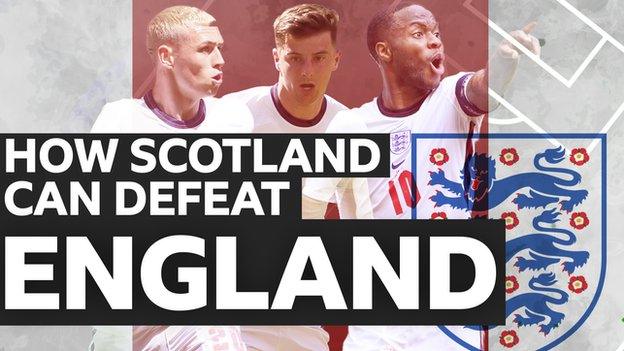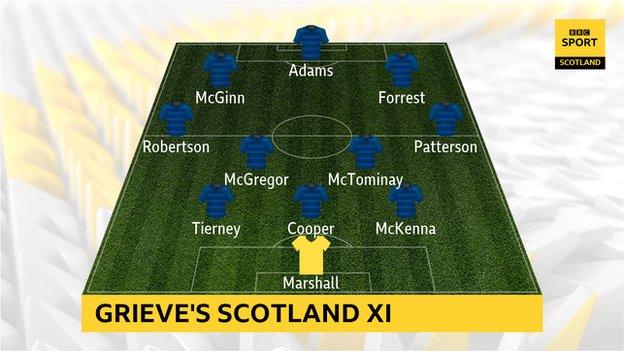Euro 2020: How do Scotland defeat England?
- Published

Scotland's tactical approach did not deliver the desired result against the Czech Republic in their Euro 2020 opener on Monday.
So what changes are needed to face the different challenge that a trip to Wembley to face group favourites England will pose?
How are England likely to set up?
Most teams will identify Andy Robertson as Scotland's best player and look to shut off the left side, double up on him, and force play to our right. It shouldn't surprise anyone that teams will try to limit his impact as much as possible, which naturally leads to allowing us to attack down the opposite flank.
The Czech Republic shut off the left and pressed tight man-to-man as expected, allowing Scotland to build down the right via Jack Hendry and Stephen O'Donnell.
Scotland left side analysis v Czech Republic.
In this example, Liam Cooper goes long but Lyndon Dykes has no support after his first touch, allowing the Czechs to collect the second ball and recover possession easily. Several Scotland players said post-match they were too direct too often.
England will have seen how the Czechs set up and how little we created from the right, and look to do the same. So looking for a solution would be wise.
If O'Donnell keeps his place, we need to play with a winger ahead of him so he has an easy outball and so Scotland can attack the English left back one-v-one.
James Forrest showed enough in his 10 minutes on Monday that he could exploit that situation, and maybe Ryan Fraser can do similar off the left, but the worry is how long they can they last from the start or if they are better being introduced in the last 20 minutes?
Also, how do Steve Clarke's side balance being a solid block, transitioning to counter attack, getting back into defensive shape quickly, then setting defensive traps to counter again against an opponent with as much talent as England? It's a tough task.
My gut feeling is we will have around 40% possession, so playing a defender on the right of a back three instead of Scott McTominay, and selecting counter attacking options are the solution in a 5-4-1 / 3-4-3 system.
We saw in organised play that O'Donnell had a problem in possession with no wide option - often he was forced to play a difficult pass into feet or down the line, or just turn back. The latter enabled the Czechs to push the lines up another 30m and force Scotland to restart their attack.
But by playing a winger in front of the Motherwell man, we can maintain balance in possession while providing a way out of our defensive block and in organised phases of play.
Scotland analysis: Stephen O'Donnell v Czech Republic
I would expect Luke Shaw or Ben Chilwell to come into the England team at left-back to try and stretch Scotland's low block. This will afford Clarke's side space in transition but also, they would need to defend the width of the pitch across the back five to stop England parking themselves in our defensive third.
England have technical players such as Raheem Sterling, Mason Mount, Jack Grealish and Phil Foden who all like to play in tight spaces and can cut through the tightest of blocks, so Scotland must stay compact at all times.
Scotland played without a clear deep-lying midfielder on Monday, which caused issues connecting the back three to the midfield and protecting the defence in transition. Easy passes through pressure opened up the press and gave the Czechs space to play out.
McTominay, John McGinn and Stuart Armstrong would prefer someone to sit and control the game and space behind the midfield and let them press, pass and run ahead of the ball. Might this be a game for Billy Gilmour to play in central midfield?
Scotland McGregor analysis v Czech Republic.
Against England, we need someone who can take the ball, give the team time to breathe, and who can protect the space in front of the defence. Callum McGregor has always been a player who is comfortable receiving and retaining possession in small spaces and who can protect the defence against mobile players.
How might Scotland counter that?

There will be phases of play against England when they decide to sit off and give Scotland possession for a period. Clarke's side need to be able to move them around and attack their full-backs one v one, while locking in the space behind the ball.
I think this team gives a good balance of possession, energy, creativity and pressing. McGinn off the left would allow space for Robertson and get the Aston Villa midfielder closer to Che Adams. Forrest can support Nathan Patterson and be the dribbler and outball in the final third, with Adams a threat on the break.
McGregor would act as the player in build up to connect the dots, with McTominay bringing physicality and pressing in midfield. I would bring on Gilmour and Fraser at some stage, probably Kevin Nisbet too, and look to maintain composure and energy in the attack.
If we do defend in a low block, having a powerful defender such as Scott McKenna may become important to defend crosses and set plays, as England have become a threat from corners in recent matches.
Scotland will need to work to stay in shape, press, and counter frequently. This takes energy and giving the front three an hour before bringing on fresh legs may maintain the intensity.
This gives two subs that are scenario dependent - what do Scotland need and how can they control what is happening in the game?